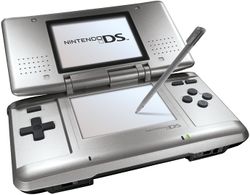| Don't like the ads? Then create an account! Users with accounts have more options than anonymous users. |
Nintendo DS
 This article is a stub. You can help Triforce Wiki by expanding it.
This article is a stub. You can help Triforce Wiki by expanding it.
| Nintendo DS | |
|---|---|

| |
| Type | Handheld |
| Release dates | |
Nintendo DS is a handheld video game console developed and distributed by Nintendo. First released in November 21, 2004, the Nintendo DS would grow to be the best selling handheld console of all time at 154.02 million units sold, and the only console to sell more units was the PlayStation 2 at 155 million units. The system would receive three major revisions, being the Nintendo DS Lite in 2006, the Nintendo DSi in 2008, and the Nintendo DSi XL in 2009. Despite being weaker than the competition on a technical level, the DS compensated by focusing on two main features. The first is the use of two different screens, which allows for unique experiences in terms of game play and presentation. The second is the bottom screen is a touch screen, which allows for faster, more intuitive controller options than buttons alone. The DS was Nintendo's first true step in catering to the casual market. Many games were not games at all, but rather applications like leisure and educational tools. Having these applications along with the touch screen on a portable system in ways predicted the smartphone boom that would rise in the following years, which would focus on similar features.
Two mainline games in The Legend of Zelda series debuted on this system, The Legend of Zelda: Phantom Hourglass and The Legend of Zelda: Spirit Tracks. A trilogy of games based on Tingle were also released on this system, being Freshly-Picked Tingle's Rosy Rupeeland, Tincle no Balloon Fight DS, and Irozuki Tincle no Koi no Balloon Trip. A remake of The Legend of Zelda: Four Swords with updated visuals and a single player mode was released exclusively on the DSiWare titled The Legend of Zelda: Four Swords Anniversary Edition on September 28, 2011.